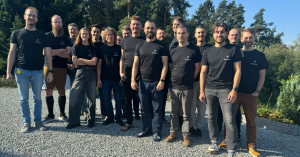Non-fungible tokens (NFTs) exploded to a $41 billion market in 2021, almost catching up with the conventional art market. Artists are jumping on the bandwagon, finding the appeal of a new market, which is ready to spend and value their digital art at unprecedented highs (the most expensive among NFT projects – a collage by digital artist known as Beeple – sold for $69 million) irresistible.
By democratizing the art world, NFTs are creating new avenues for artists and collectors. Yet the versatility of the blockchain technology and the parallel development of 3D virtual worlds – the metaverse – create so many applications for NFTs (from real estate to fashion) that we’re beginning to see a new model of consumption and production. In a world that is increasingly aware and intentional about our environmental footprint, the hidden impact of the booming NFT market has been explored many times, with new avenues and projects emerging in response.
Here, The Recursive explores:
- What NFTs are, and what makes them so appealing;
- Why the current predominant technology behind NFTs has dire consequences for the environment;
- How low-energy cryptocurrencies and other solutions can improve the impact of NFTs;
- The projects making the technology more efficient and eco-friendly.
NFTs in a nutshell
Essentially, an NFT is a digital asset with a unique string of code, recorded, stored, and traded on blockchain technology using cryptocurrency. Being non-fungible, the asset is one-of-a-kind and thus cannot be interchanged with something else. It can be anything, from paintings, to songs, videos, a travel package, and even buildings.
While digital art is not new, before blockchain, it was difficult to own, let alone transfer a digital asset. Artists would have to sell multiple copies of the same artwork at very low prices to have any profit. Yet that meant erasing some of the value. You wouldn’t duplicate and resell a physical artwork for the same price.
Tokenization allowed creators and collectors to verify the uniqueness of an item and prove its ownership. Now, artists can “mint” or publish their artwork on the blockchain and sell it, essentially offering ownership and management rights to buyers, while receiving royalties. NFTs are further traded and their value fluctuates depending on demand.
Moreover, centralization in the art market has been leaving many artists with a low statistical chance of success because of a combination of factors out of their control including status, gender, race, or geography. Blockchain’s decentralized system promises an easier and more direct connection between digital artists and collectors by reducing pre-conditions and intermediaries.
“The current mainstream global adoption of NFTs is an example of a simple yet powerful application of the blockchain. We use the technology to validate the authenticity of a given digital artwork the same way physical art is authenticated by a recognized body of experts or local authorities. The advantage is that the authors can start offering their works to a global audience in a matter of minutes, and then buyers can exchange it again and again at a very low transaction cost and short periods of time, thanks to one of the popular NFT marketplaces,” Christo Peev, serial entrepreneur, investor, and owner of an the “It Remains” NFT project founder tells The Recursive.
For many blockchain natives like Peev and his partner Vasil Tuchkov, releasing an NFT collection is a natural step.
The hidden cost on the environment
The impact of an NFT project comes from the blockchain and cryptocurrency systems used by the marketplaces where NFTs are traded. And like most emerging technologies, they are not very efficient in all dimensions.
The main vulnerability lies in one of the key strengths offered by the system: its ability to verify information. To do so, some cryptocurrencies such as Ethereum and Bitcoin use the proof-of-work model whereby miners around the world use a large amount of computational power to verify records and transactions.
Taking Bitcoin as an example, estimates show that this model has an annualized energy consumption of 131.38 TWh, more than some small countries. In other terms, each Ethereum transaction is equivalent to the energy consumption of an average US household over more than eight days.
All this makes the proof-of-work model difficult to imagine at scale. And yet the majority of NFT transactions are done through PoW-running cryptocurrencies.
Whether it is the artist’s or collector’s responsibility once they participate in the NFT market is up for debate. Yet it has been argued that with NFT growing in importance, it demands more transactions in the blockchain, and therefore mining and associated emissions.
A more sustainable approach to managing NFT projects
Running on more energy-efficient blockchains
The good news is that most emerging technologies tend to improve over time.
“The biggest and most decentralized network Ethereum is changing it’s consensus algorithm and will reduce its energy consumption by 99.95%. This should happen by the end of 2022 and it’s already live for public testing. There are many other growing blockchains like Solana, Polkadot, Avalanche, which already have implemented energy-efficient operating mechanisms, but still lack security and adoption by a wider pool of developers, which results in less applications and development tools. NFT marketplaces allow users to publish and trade on multiple blockchain networks at the same time which is a great feature accelerating the transition to low-carbon transactions,” Christo Peev explains.
Christo is talking about Ethereum’s announced intention to change to a proof-of-stake transaction model, which requires less computational complexity and energy use without compromising the safety of the system. However, this poses technical challenges, and some still doubt that Ethereum will see the transition through. If not everyone in the system agrees to the change, the network could fall apart.
Some of the more popular marketplaces already have integrations with more energy-efficient blockchains. OpenSea, for instance, is actively supporting Polygon and Klaytn, while Rarible also uses both Flow and Tezos.
Mintbase, for instance, uses the NEAR Foundation’s proof-of-stake blockchain. The NEAR protocol was also awarded the climate-neutral product label after working with decarbonization consultancy company South Pole to offset the carbon footprint of its blockchain emissions by investing in climate action projects.
As a next step, the three parties collaborated on organizing a climate-conscious NFT art auction, to highlight the need to address the environmental impact of NFT projects. Within the projects, proceeds from the sale of the NFTs are equally split between the artist and climate action projects, such as driving the clean energy transition in India.
Supporting environmental projects
This way of giving back to the planet can be found in other projects, too. World of Waves, for instance, aims to support non-profit organizations that fight to protect the oceans by helping them fundraise through NFT projects and blockchain.
Meanwhile, Christo Peev’s project “It Remains” is inspired by the dystopian future of the graphic novel with the same name, raising awareness about the dangers of our current use of plastic.
“It is portraying a world on the brink of erasure, the aftermath of civilization. What remains is a great swallowing pit, consuming the leftovers of a world of plastic, bone, and sand. Raising awareness towards global environmental matters such as a plastic-free future is a cause that we have supported actively in our personal lives and now we want to do it at a bigger scale,” Peev says.
The impact royalties collected through the sale of It Remains NFTs will accumulate in a community-controlled wallet, and NFT owners will have the option to vote on directing the funds to specific projects with positive environmental impact.
Finding new efficiencies
Stakeholders are also looking for ways to improve the efficiency of the already widespread blockchain models.
With the issue of blockchain scalability at stake, StarkWare is proposing solutions to reduce the energy impact of Ethereum transactions. StarkWare offers Ethereum scaling solutions that use “zero knowledge” rollup technology to execute transactions off-chain and store only transaction data on-chain. This results in less network congestion, and therefore less power use. In 2021, StarkWare was valued at $2 billion after raising $50 million in a Series C funding round.
The other type of layer 2 constructions (Ed.note that do not run on the Ethereum base layer, but on top of it), called optimistic rollups, is exemplified by Arbitrum One, developed by Offchain Labs.
Switching to renewable energy
Finally, another solution to the emissions problem posed by the underlying infrastructure on which NFTs are managed is running it on clean energy. Currently, several survey findings estimate that, on average, 39% of proof-of-work mining is powered by renewable energy sources, mainly hydroelectric energy.
However, some experts have argued that this does not solve the energy intensity problem. Relying on renewable energy sources for all blockchain transactions would put a lot of pressure on electricity grids, competing with more essential uses.








